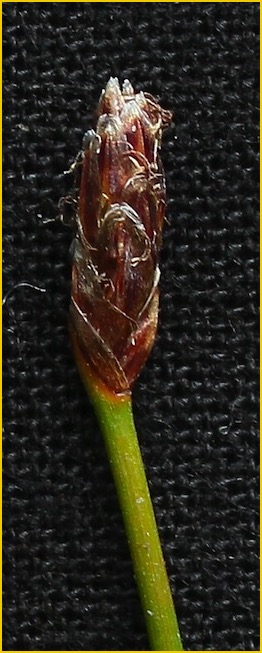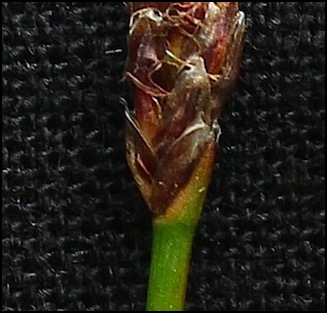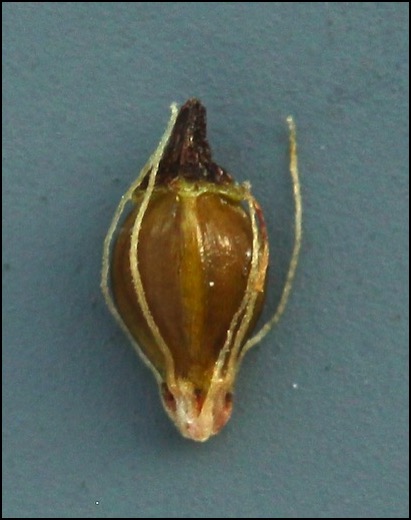Separation of confusion pairs: Eleocharis …
multicaulis versus quinqueflora
Shared features
➢ tufted
➢ the basal glume +/- surrounds the base of the spikelet
➢ stigma 3-forked
➢ may grow in similar open seepage areas in mineral-influenced mires, sometimes in close proximity
Separation
Should not present problems when shoots are mature, as multicaulis is a more substantial plant, and typically has more the ‘look’ of larger species. More tricky when slender, and/or immature: in young spikelets the basal glume is a greater proportion of the spikelet.
Readily separated on:
➢ length of basal glume versus length of (mature) spikelet:
multicaulis has the basal glume about 1/4 the length of the spikelet (left, below)
quinqueflora has the basal glume about 1/2 the length of the spikelet (right, below), or even more
➢ spikelet with more flowers in multicaulis, making a longer spikelet
➢ upper leaf-sheath opening:
multicaulis has an obliquely-cut opening, creating an apex (about 90 degrees, or ‘sharper’; see figure in species account of multicaulis)
quinqueflora has a +/- transverse/truncate opening

multicaulis

quinqueflora
➢ basal glume (often?) notched at apex in multicaulis (below); rounded in quinqueflora

➢ style-base, very distinct in each case: constricted at attachment to nut in multicaulis; confluent with nut in quinqueflora

multicaulis
quinqueflora
(not quite to scale)
➢ multicaulis stouter with wider stem
Summary
| multicaulis | quinqueflora | |
| basal glume: length vs. length of spikelet | approx. 1/4 | 1/2 or more |
| basal glume: apex | often notched, hence bilobed | rounded, not notched |
| style-base | wide at junction with nut, with ‘neck’ | narrow; confluent with nut, no ‘neck’ |
| flowers in spikelet | 10 or more | 7 or fewer |
| nut | rather small: to 1.5 mm | larger: 2 mm or more |
| stem diameter | typically 1 mm or more | usually less than 1 mm |
| upper leaf-sheath opening | oblique/slanting; has an apex | truncate; no apex |
Links to the other Eleocharis spike-rush pages (also accessible from the sidebar)
Species pages
Separation of similar pairs
Other information
